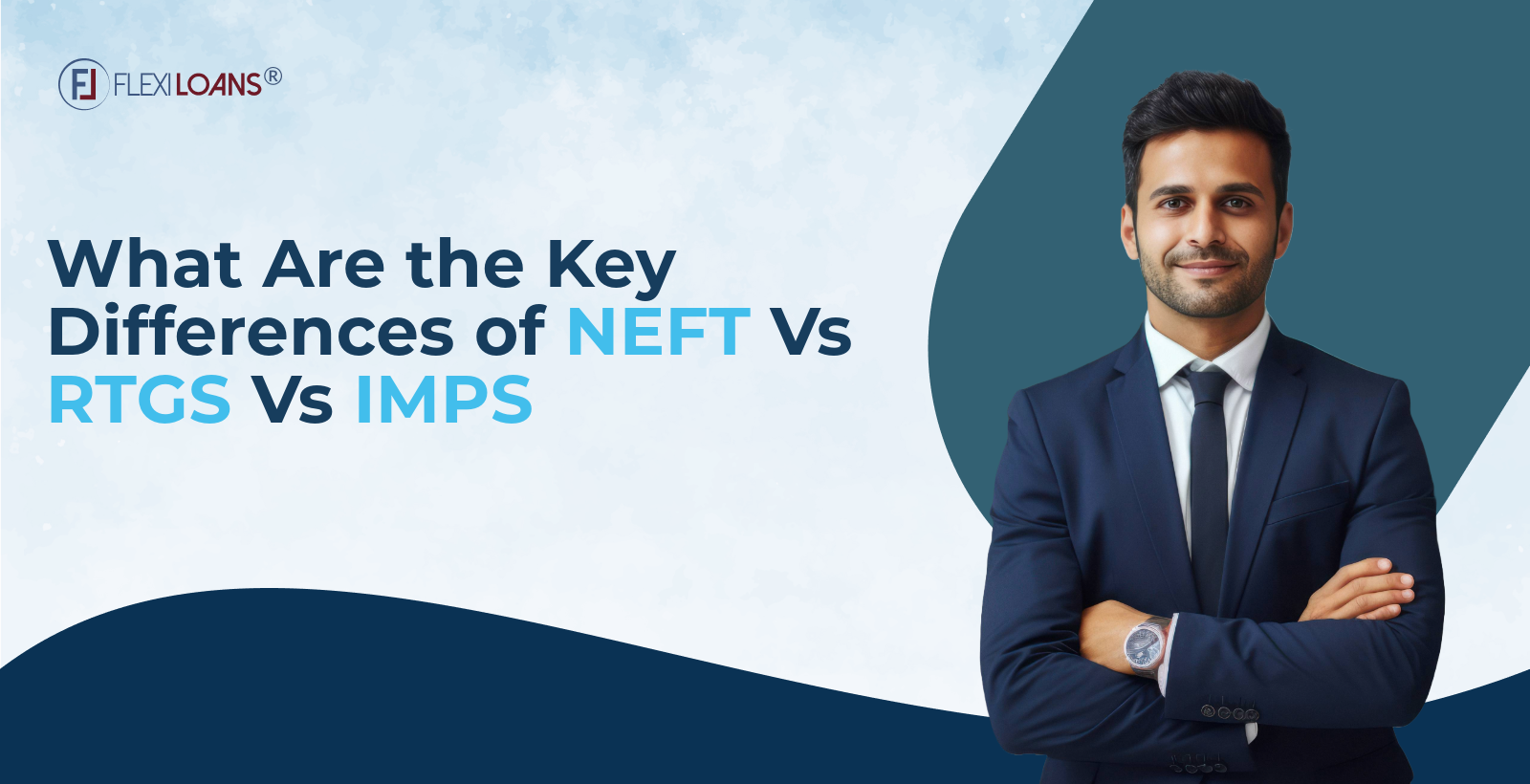May 15, 2025
Aug 01, 2025

Whether you’re paying a supplier or just sending funds to a friend, there are numerous transactions that we all make every day. Although UPI is ideal for small payments, it does not process transactions above ₹1 lakh. This is where the NEFT, RTGS, and IMPS prove useful.
If you had to send money through your bank, you’d definitely come across NEFT, RTGS, and IMPS. While they all help you transfer money from one account to another, you must know the difference between NEFT vs RTGS, vs IMPS to ensure you are choosing the right payment system.
The RBI’s Payments Vision 2025 predicts that RTGS will continue to lead in transaction value, while IMPS and NEFT will increase at an annualised pace of 20%. If you are running a small business, know the key differences between NEFT, RTGS, and IMPS to choose the right payment system.
What is NEFT (National Electronic Funds Transfer)?
NEFT full form stands for National Electronic Funds Transfer, which is one of India’s widely used payment systems. It works on a batch-processing system that groups transactions together and processes them in half-hourly cycles throughout the day using batch processing. The Reserve Bank of India (RBI) introduced NEFT to make banking smoother, especially for everyday transactions.
While it’s not instant like IMPS or RTGS, the NEFT system still offers a reliable way to send money, especially when time isn’t a pressing issue. In terms of cost, NEFT transfers are usually free or involve minimal charges, especially if done via online banking. It’s safe, convenient, and well-suited for small to medium-sized transfers.
Features of NEFT Transfer
- No Minimum Limit: NEFT is available for both small and medium transactions, with a transfer amount of as little as ₹1.
- 24/7 Availability: NEFT operates 24/7, including weekends and holidays.
- Nationwide Service: You can transfer funds to any bank and branch account in India that accepts NEFT.
- Batch Processing: NEFT processes transactions in batches every 30 minutes, on average.
- Secure and Safe: The Reserve Bank of India (RBI) regulates NEFT, which guarantees a high degree of security for every transaction.
- Online and Offline Access: You can use mobile applications, online banking, or a bank branch to start NEFT transfers.
How does NEFT work?
NEFT uses the delayed net settlement (DNS) model for easy money transfers between banks. In DNS, the system handles transactions in batches and completes them at predetermined times throughout the day. It allows individuals and businesses to move money across Indian financial institutions. One of the biggest benefits is that the RBI didn’t set any limit for NEFT transactions.
What is RTGS (Real-Time Gross Settlement)?
RTGS full form stands for Real-Time Gross Settlement. The system facilitates large-value transactions by enabling immediate fund transfer. This is why business owners and individuals who need to transfer funds immediately prefer it over NEFT.
The RTGS system processes transactions instantly, without delay, under its “Real-Time” feature. Gross Settlement, on the other hand, settles each transaction individually in RTGS, meaning there’s no netting or waiting. RTGS transfer is also one of India’s most secure and fastest payment systems.
Features of RTGS Transfer
- Real-time Online Fund Transfer: The RTGS system transfers funds in real-time, making it ideal for moving funds urgently.
- High-value Transactions: The payment method allows you to transfer a minimum of ₹2 lakh, facilitating high-value transactions.
- Safe and Secure: The RBI ensures that all transactions are completely safe and that the server used to process them is reliable and secure.
- Immediate Clearing: RTGS is a speedy settlement system in contrast to NEFT, which has a longer transfer time.
- Operational Six Days a Week: Banks conduct RTGS transfers during 8:00 AM to 5:00 PM business hours and on all weekdays and the first and third Saturdays.
How does RTGS work?
RTGS transfers are ideal for transferring amounts ₹2 lakh or more. The first stage of an RTGS payment begins when the sender inputs the recipient’s bank account number, transfer amount, and information. Once confirmed, the bank checks the amount, follows a quick verification process, and transfers money in real-time with immediate settlement.
What is IMPS (Immediate Payment Service)?
IMPS stands for Immediate Payment Service, which is an interbank electronic money transfer system that enables safe and quick money transfers via ATMs, online banking, and mobile banking. The National Payments Corporation of India (NPCI) introduced the payment system in 2010. What makes it stand out is that it works round-the-clock, even on Sundays and holidays.
Users typically use IMPS for small-to-medium amount transfers, with a usual upper limit of ₹2 lakh for individuals (though some banks allow higher limits for corporate clients). If you need to send money urgently, whether it’s to family or for a quick purchase, IMPS India is the best option.
Features of IMPS Transfer
- 24/7 Availability: IMPS service provides flexibility and convenience by allowing transactions through ATMs, online banking, or mobile banking.
- Limit on Daily Transactions: Depending on the particular regulations of their bank, users can transfer up to ₹5 lakh per day.
- Several Platforms: The sender needs the beneficiary’s bank account number and IFSC code or mobile number and MMID (Mobile Money Identifier) to initiate a transfer.
- Safe and Dependable: Strong authentication and encryption procedures guarantee the security of every IMPS transaction.
- Transfers in Real Time: The instantaneous transmission of funds reduces transaction delays.
How does IMPS work?
The sender must provide the beneficiary’s bank account number and IFSC code, or mobile number and MMID (Mobile Money Identifier), to initiate a transfer. The system credits the recipient’s account in real time after it authorises the transaction. Users in India often use IMPS for small-to-medium value transactions, and the NPCI governs this system.
NEFT vs RTGS vs IMPS: Key Differences
Choosing the right payment system is important in order to meet your fund transfer requirements. The key element of NEFT RTGS IMPS comparison is that they all serve different fund transfer needs, amounts, and timelines. Here are the key differences between NEFT, RTGS, and IMPS you must know:
| Features | NEFT | RTGS | IMPS |
| Full Form | National Electronic Funds Transfer | Real-Time Gross Settlement | Immediate Payment Service |
| Speed | Batch processed (within hours) | Real-time | Instant (real-time) |
| Minimum Limit | No minimum | ₹2 lakh | ₹1 (may vary by bank) |
| Maximum Limit | Bank-defined (often ₹10 lakh) | No upper limit (bank-defined) | ₹2 lakhs (higher for corporation) |
| Availability | 24×7 (including holidays) | 24×7 (bank-dependent) | 24×7 (all days) |
| Fees | Free or minimal fees | Slightly higher | Low |
| Channels Supported | Net banking, mobile, and branch | Net banking, mobile, and branch | Mobile app, net banking, ATM, SMS |
| Regulatory Body | Reserve Bank of India (RBI) | Reserve Bank of India (RBI) | National Payments Corporation of India (NPCI) |
| Use Case | Individual, non-urgent transfers | Urgent, high-value transfers | Fast, anytime transfers |
Which Method Should You Choose? NEFT, RTGS, or IMPS?
The NEFT RTGS IMPS comparison shows that while all the payment systems serve the same basic purpose, they’re each tailored to different needs. This makes choosing the right payment system more important. You must choose them based on how quickly you want the money to transfer, how much you’re sending, and when you’re sending it.
Each payment method comes with its strengths. RTGS is ideal for big amounts, whereas IMPS is ideal for everyday transfers. Choosing the right one depends on your need for speed, the amount you’re sending, and the level of convenience you’re after.
- NEFT: Use NEFT if you’re making small-to-medium domestic payments where immediate settlement isn’t critical. It’s ideal for regular transactions like paying bills, freelancers, or vendors.
- RTGS: Choose RTGS if you’re transferring ₹2 lakh or more and want the funds to reflect instantly. It’s best for high-value, time-sensitive payments like real estate transactions or urgent business transfers.
- IMPS: Choose IMPS when you need to send money quickly, especially outside of banking hours. It’s perfect for everyday personal transfers or emergencies.
When deciding between NEFT vs RTGS vs IMPS, think about the urgency, the amount, and how you prefer to make the transfer (mobile, online, or at the bank). There’s no one-size-fits-all answer, just what fits your current need.
Benefits and Drawbacks of NEFT, RTGS, and IMPS
Every payment system has its own pros and cons, and knowing both can help you avoid surprises. Here is a comparison of the benefits between NEFT vs RTGS, vs IMPS:
| Payment System | Benefits | Drawbacks |
| NEFT | Absence of real-time transferProcessed in a half-hourly batches Can have delays during high traffic | Absence of real-time transferProcessed in half-hourly batches Can have delays during high traffic |
| RTGS | Minimum limit of ₹2 lakh May not be available via mobile apps. Not suitable for small transfers | Minimum limit of ₹2 lakh May not be available via mobile apps Not suitable for small transfers |
| IMPS | Instant transfer anytime Works via mobile, internet, ATM, SMS Ideal for small to medium payments User-friendly | Limit of ₹5 lakh (may vary by bank)Higher chance of errors if mobile details are incorrect |
How to Make an NEFT, RTGS, or IMPS Transfer?
Initiating a digital transfer is straightforward across all three systems. However, the steps differ across modes of payment.
How to Make an NEFT Transfer
- Log In to Your Bank Account: To use the online mobile banking services offered by your bank, you must first log in to your bank account.
- Go to the Funds Transfer: Next, find “Funds Transfer” or “Payments” under services and choose NEFT.
- Add the Beneficiary: Although it’s not mandatory for all banks, you can add the receiver as a beneficiary by entering the IFSC code, account number, and beneficiary’s name.
- Enter the Details: Here, you must enter all the bank details and then enter the transfer amount as well as any optional comments.
- Verify the Transaction: Before initiating the transaction, use the transaction PIN or OTP to validate it.
- Settlement: The following NEFT batch will complete the transfer, which usually takes two hours.
How to Make an RTGS Transfer
- Log In to Your Bank Account: Open online banking on your phone or laptop and then log in to your account.
- Visit the RTGS Transfer Service: Choose RTGS from the payment or money transfer section.
- Add the Beneficiary and Activate Them: Enter the IFSC code and the beneficiary’s account information; activation might take a few hours.
- Complete the Transfer Information Form: Enter the purpose, comments, and the amount (minimum ₹2 lakh).
- Verify and Authorise Payment: Verify the information again and confirm using a secure PIN or OTP.
- Instantaneous Transfer of Funds: The beneficiary’s account is instantly credited with the amount.
How to Make an IMPS Transfer
- Account Login: Log in to your online banking or mobile application.
- Choose IMPS Transfer: Decide whether to use Quick Transfer or IMPS.
- Choose the Transfer Type: Here, you must select either of the following:
- Cell Phone Number and MMID, or
- Your account number and IFSC code
- Input the Transfer Information: Provide the money (up to ₹5 lakh), the beneficiary’s information, and any comments.
- Verify and Authenticate: Use a UPI PIN or OTP to approve the payment.
- Instant Transfer Complete: At any time of day, money is instantly deposited into the recipient’s account.
How Safe are NEFT, RTGS, and IMPS Transfers
When it comes to transferring money digitally, security is just as important as speed. All three systems are backed by the Reserve Bank of India (RBI) and NPCI, and follow strict protocols to keep your money safe:
- End-to-end encryption to protect data
- Two-factor authentication (2FA) during login and transactions
- Time-stamped transaction logs for complete traceability
- Bank-level firewalls and real-time monitoring
To stay safe, never share your OTP, avoid clicking/tapping on suspicious links, and always verify the bank’s official website or app before logging in. The security of NEFT, RTGS, and IMPS is robust, but user awareness plays a huge role in keeping fraud at bay.
Common Issues with NEFT, RTGS, and IMPS Transfers
Even with the best payment systems, things can go wrong. Knowing how to troubleshoot payment issues can save you a lot of stress. Here are a few common issues and how to deal with them:
- Delayed Transactions: NEFT can take time due to batch processing; RTGS might get held up if initiated after the cutoff. Wait for 30-60 minutes, most issues auto-resolve.
- Transaction Failures: This can happen due to wrong account numbers, incorrect IFSC codes, or server issues. Contact your bank’s customer support with the transaction reference number to enquire about failure.
- Funds Debited but Not Credited: Sometimes, the money is deducted but doesn’t reach the recipient immediately. For these transactions, banks usually reverse the amount within 2-3 working days.
Conclusion
You need a reliable payment system by your side to make the fund transfer safe and easy. The need, however, increases if you run a business that demands transferring funds daily. NEFT, RTGS, and IMPS are the three most secure payment systems that you have access to in India. These payment transfer systems make it easy to move funds from one account to another. If you are running a business, business funding is as important as payment transfer systems. Whether you want to restock your inventory or pay salaries, FlexiLoans offers unsecured business and MSME loans with up to ₹50Lakhs. Apply for a small business loan now to meet all your business needs and expand it.
Deprecated: Function get_the_author was called with an argument that is deprecated since version 2.1.0 with no alternative available. in /var/www/html/wordpress/flexiloans.com/blog/wp-includes/functions.php on line 6114
Deprecated: Function get_the_author was called with an argument that is deprecated since version 2.1.0 with no alternative available. in /var/www/html/wordpress/flexiloans.com/blog/wp-includes/functions.php on line 6114







